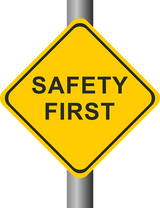The Dangers of Worker Fatigue (and How To Prevent It)
The Bureau of Labor Statistics (BLS) reports that nearly 15 million work full-time (8 or more hours) evening shifts, night shifts, rotating shifts, or other irregular schedules. Schedules such as these often interfere with workers' sleep habits, resulting in fewer hours of sleep and a greater chance of fatigue.
When a worker is fatigued, he or she is more likely to make mistakes while on the job. Depending on the worker's position, this may or may not be a problem. Workers in the construction industry, for instance, may injure themselves or others when fatigued. It only takes a wrong shift in body weight when you're on a ladder or scaffolding to tumble to the ground below. And using power tools while fatigued are just as dangerous, if not more dangerous.
Symptoms of fatigue may include one or more of the following:
- Tiredness
- Lack of appetite
- Slow, sluggish movement
- Reduced strength
- Irritability
- Difficulty staying awake
According to a study conducted by the Alberta Human Resources and Employment, fatigue has a similar effect to the alcohol intoxication. Staying awake for 17 hours is roughly the equivalent to a blood alcohol content of 0.05, whereas staying away for 21 is equivalent to a blood alcohol content of 0.08, and 24-25 hours of being awake is equivalent to a blood alcohol content of .10. Assuming these numbers are correct, staying awake for a full 24 hours is the same as being moderately intoxicated.
But fatigue affects workers in a number of ways, some of which are obvious while others are more discreet. See below for a list of the different ways fatigue impacts workers:
- Increased chance of injury.
- Weakened immune system, which subsequently leaves workers more susceptible to disease and illness.
- Reduced reaction times.
- Lower productivity.
- Reduced communication.
- Increased tendency for taking risks.
- Loss of short-term memory.
- Inability to handle stress on the job.
- Higher medical costs.
- Narrow attention span.
So, how can employers prevent worker fatigue? There are several different precautions employers can take to protect against worker fatigue, one of which is to limit shift hours. While there are laws in place which limit the number of consecutive hours employees are allowed to work, many employers fail to follow them. For complete details on U.S. work hour laws, visit http://www.dol.gov/dol/topic/workhours/.
Fatigue can also be prevented by breaking up shifts with breaks. Again, this is something that's mandatory in the U.S. under federal law but not always followed.
Have any other fatigue-fighting tips you'd like to share with our readers? Leave them in the comments section below!
Recent Posts
-
Fire Safety in the Workplace: What You Need to Know
What steps are you taking to prevent fires in your workplace? According to the U.S. Occupational Saf …Aug 23rd 2023 -
Is It Safe to Go Jogging With a Cold Infection?
If you're suffering from a cold infection, you might be wondering whether it's safe to go jogging. T …Aug 22nd 2023 -
5 Safety Tips to Follow When Using a Powder-Actuated Tool
Powder-actuated tools are commonly used to join materials to steel and concrete. Also known as Hilti …Aug 20th 2023




